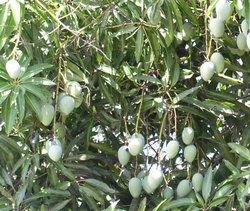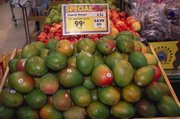Mango
|
|
| Mango | ||||||||||||
|---|---|---|---|---|---|---|---|---|---|---|---|---|
 Immature Black Mango fruit | ||||||||||||
| Scientific classification | ||||||||||||
| ||||||||||||
| Species | ||||||||||||
|
M. altissima |
The mango (Mangifera spp.; plural mangos or mangoes) is a genus of about 35 species of tropical fruiting trees in the flowering plant family Anacardiaceae, native to India and Indo-China, of which the Indian Mango M. indica is by far the most important commercially. Reference to mangos as the "food of the gods" can be found in the Hindu Vedas. The name of the fruit comes from the Tamil word man-kay, which was corrupted to manga by the Portuguese when they explored western India. The mango also features as a common motif, known as the paisley, in Indian textiles.
The mango is now widely cultivated as a fruit tree in frost-free tropical and subtropical climates in North, South and Central America, the Caribbean, South and Central Africa, the Indian Subcontinent, the Philippines and Australia. It is easily cultivated and now there are more than 1,000 cultivars, ranging from the turpentine mango (from the strong taste) to the huevos de toro, generally translated as "bull's testicles", from the shape and size. The mango is reputed to be the most commonly eaten fresh fruit worldwide. Mangos also readily naturalize in tropical climates. Some lowland forests in the Hawaiian Islands are dominated by introduced mangos.
| Contents |
Description
Mangos become very large trees. In height a mango tree may reach 35-40 meters (130 feet) with a span of 10 meters (33 feet) at the top. New leaves are almost a salmon color that rapidly changes to a dark glossy red, then dark green as they mature. When the small white flowers emerge they give off a mild sweet odour suggestive of lily of the valley. After the flowers fall off, the fruits may take from three to six months to ripen.
The mango fruit, when fully mature, hangs from the tree on long stems. They are variable in size, from 10-25 cm long and 7-12 cm diameter, and may weigh up to 2.5 kg. The fruits come in a variety of colors: green, yellow, red, or various combinations of these colors. When ripe, the unpeeled fruit gives off a distinctive, slightly sweet smell. In the center of the fruit (a drupe) is a single flat, oblong stone that can be fibrous or hairless on the surface, depending on variety. Inside the shell, which is 1-2 mm thick, is a paper-thin lining covering a single seed, 4-7 cm long, 3-4 cm wide, 1 cm thick.
The fruit flesh of a ripe mango contains about 15% sugar, up to 1% protein, and significant amounts of vitamins A, B and C. The taste of the fruit is very sweet, with some varieties having a slight acidic tang. The texture of the flesh varies markedly between different cultivars, some have quite a soft and pulpy texture similar to an over-ripe plum, others have a firmer flesh much like that of a cantaloupe or avacado, and in some cultivars the flesh can contain fibrous material. Mangoes are a very juicy fruit; the sweet taste and high water content make them refreshing to eat, however the juice can make eating them quite a messy affair.
The mango is in the same family as poison ivy and contains urushiol, though much less than poison ivy. Some people get dermatitis from touching mango peel or sap. Persons showing an allergic reaction after handling a mango can usually enjoy the fruit if someone else first removes the skin. The leaves are also toxic to cattle.
It is reputed that mangos soothe the intestines, which makes them easy to digest. In India, where mangoes are the National Fruit, they are used to stop bleeding, to strengthen the heart, and to benefit the brain.
Methods of eating a mango fruit
Mango_24.jpg
Some people claim that the safest way to eat a mango is in the bathtub, or sitting naked on a deserted beach, or even on top of a mango tree itself. Generally, once ripe, they are quite juicy and can be very messy to eat. However, those exported to temperate regions are, like much tropical fruit, picked under-ripe. Although they are ethylene producers and ripen in transit, they rarely have the same juiceness or flavour as the fresh fruit. A ripe mango will have an orange/yellow or reddish skin. To allow a mango to continue to ripen after purchase, store in a cool, dark place, but not your refigerator. Refrigeration will slow the ripening process.
The small varieties, usually somewhat yellow in color, can be rolled on a flat surface in the same way a lemon is rolled before extracting the juice. It is ready for eating when the big stone can be rotated without breaking the skin. With the teeth rip off a piece of skin at the top of the mango and place your mouth over the hole. Squeeze the fruit from the bottom up, as if squeezing toothpaste from the bottom of the tube.
With any of the larger varieties of mango, the operation is less hazardous: place the fruit lengthwise on a table and feel for the rather flat stone (containing the seed), which should lie horizontally inside the skin about midway through the fruit. Slice the mango so that the knife just passes over the flat surface of the stone. Turn the mango over and repeat the process, cutting across the other flat surface.
With each big slice that has been removed, cut hatch marks through the flesh just down to the skin. Then, holding the piece flesh side up, press the thumb on the skin side underneath as if turning the piece inside out. Many bite-sized pieces of flesh will pop up and can be cut out to put into a fruit salad or other preparation. This technique is sometimes called the hedgehog method because of the appearance of the prepared fruit. An alternative to the hedgehog method is to use a spoon to scoop out pieces of the fruit from the exposed "cheeks".
A simple way to eat a large mango 'as is' involves using a knife. Start by removing part of the skin and then slice out bite-sized pieces with the knife. Remove more skin to expose more flesh. Expect to get juicy hands when eating the last part, when there is no skin to hold with your hand.
Another way to eat a Mango is to simply use a sharp knife to peel the skin completely. Then make horizontal and vertical cuts on each side till the flat stone is reached. Slice off the flesh from each side of the stone and then slice the remaining flesh left on the side of the stone. This method works best on mangoes that are ripe and which have firm flesh.
Mango in other forms and dishes
Ripe mangoes are extremely popular throughout Latin America. In Mexico, sliced mango is eaten with chili powder and/or salt. In Guatemala, Ecuador and Honduras, small, green mangoes are popular; they have a sharp, brisk flavor like a Granny Smith apple. Vendors sell slices of peeled green mango on the streets of these countries, often served with salt. In Hawai'i it is common to pickle green mango slices.
Mangoes are widely used in chutney, which in the West is often very sweet, but in the Indian subcontinent is usually sharpened with hot chilis or limes. In India, mango is often made into a pulp and sold as bars like chocolate, and unripe mango is eaten with chili powder and/or salt. In the Philippines, unripe mango is eaten with bagoong, a salty paste made from fermented fish or shrimp.
Mango is also used to make juices, both in ripe and unripe form. Pieces of fruit can be mashed and used in ice cream; they can be substituted for peaches in a peach (now mango) pie; or put in a blender with milk, a little sugar, and crushed ice for a refreshing beverage. A more traditional Indian drink is mango lassi, which is similar, but uses a mixture of yoghurt and milk as the base, and is sometimes flavoured with salt or cardamom.
Dried unripe mango used as a spice in south and southeast asia is known as amchur.
Important Mango cultivars
NutritionFacts_mango.png
Many hundred named mango cultivars exist. In mango orchards, several cultivars are always grown intermixed to improve cross-pollination. In India, the commonest cultivar is 'Alphonso', known as the King of Mangoes. The best 'Alphonso' mangos are reputed to come from the town of Ratnagiri in Maharashtra. About 80% of mangos in UK supermarkets are of the single cultivar 'Tommy Atkins', which dominates the world export trade. It travels well and has a good shelf-life, but does not have the same flavour as some less common varieties obtained from Asian shops.
The following are among the more widely grown, listed by the country in which they were selected or are most extensively cultivated:
- Australia
- 'Kensington Pride' (also known as 'Bowen Special'
- Bangladesh
- 'Himsagar', 'Langra', 'Fazli', 'Ashini', 'Khirshapat', 'Raj-bhog', 'Lokhon-bhog'
- Cambodia
- 'Cambodiana'
- Cameroon
- 'Am鬩or饠du Cameroun'
- India
- 'Alphonso' (also called 'Hapoos'), 'Amrapali', 'Bangalora', 'Banganapalli' (a.k.a. 'Benishaan'), 'Bombay', 'Bombay Green', 'Chausa', 'Chinna Rasalu', 'Dashaheri' ('Daseri'), 'Fazli', 'Fernandian', 'Gulabkhas', 'Himayath' (a.k.a. 'Imam Pasand'), 'Himsagar', 'Jehangir', 'Kesar', 'Kishen Bhog', 'Lalbaug', 'Langda' ('Langra'), 'Mallika', 'Mankurad', 'Mulgoa', 'Neelam', 'Pairi', 'Pedda Rasalu', 'Rajapuri', 'Safeda', 'Suvarnarekha', 'Totapuri', 'Vanraj', 'Zardalu'
- Indonesia
- 'Arumanis', 'Golek'
- Pakistan
- 'Chaunsa', 'Langra', 'Anwar Ratol', 'Sindhri', 'Dasehri', 'Fazli'
- Philippines
- 'Carabao'
- USA: Florida
- 'Haden', 'Irwin', 'Keitt', 'Kent', 'Tommy Atkins', 'Zill'
- USA: Hawaii
- 'Momi K', 'Pope'
- West Indies
- 'Am鬩e', 'Dou-douce', 'Graham', 'Julie', 'Long', 'Madame Francis' (Haiti), 'Rose', 'Spice-Box', 'Starch'
A good list of additional leading cultivars can be found at the cultivar list link in the External links below (although this list omits 'Julie' of the West Indies).
Fair trade
Mangoes are a popular fruit with consumers around the world. However, many mango farmers receive a low price for their produce. This has led to mangoes being available as a 'fair trade' item in some countries.
External links
- Mango Fruit Facts (http://www.crfg.org/pubs/ff/mango.html)
- Mango cultivar list (http://www.rajans.com/cultivars.htm)
- McGregor on Mango Pollination (http://bee.airoot.com/beeculture/book/chap5/mango.html)
- Mango Post Harvest (http://www.fao.org/inpho/compend/text/Ch20sec1.htm#)
- Health and Mangoes (http://www.nationalpak.com/healthmangoes.asp)

